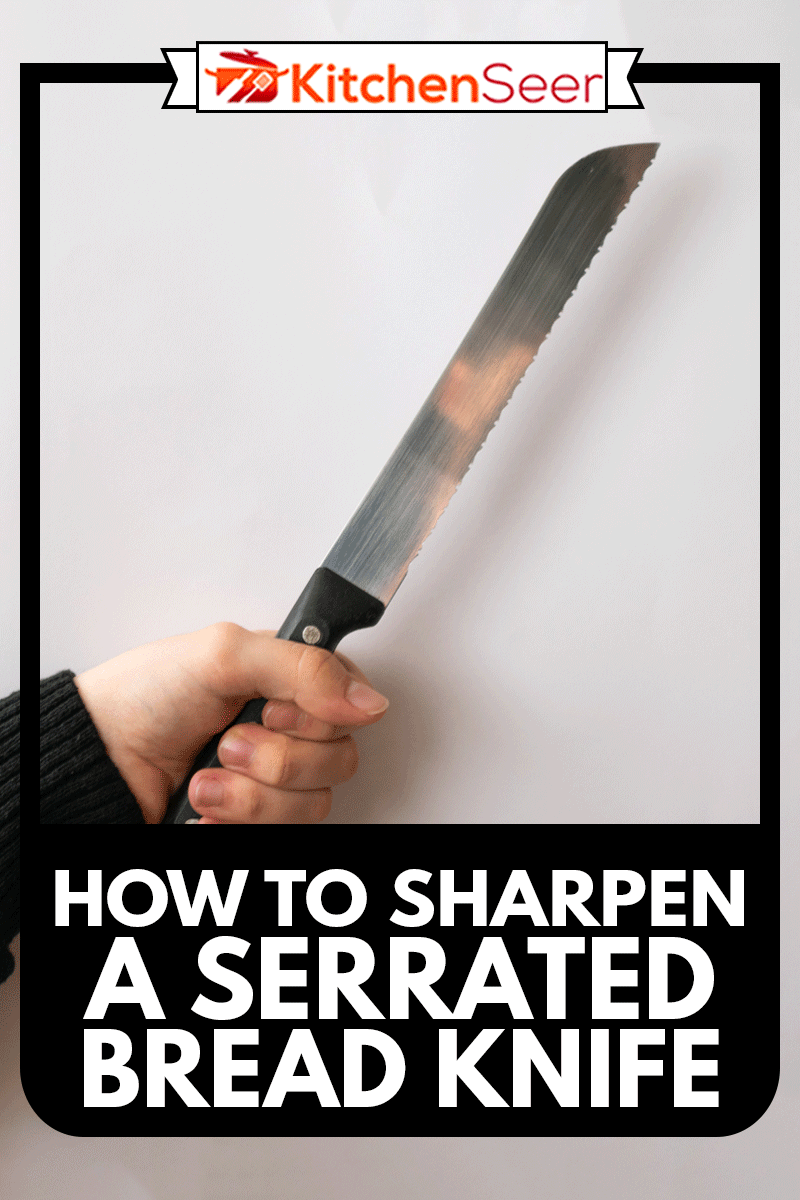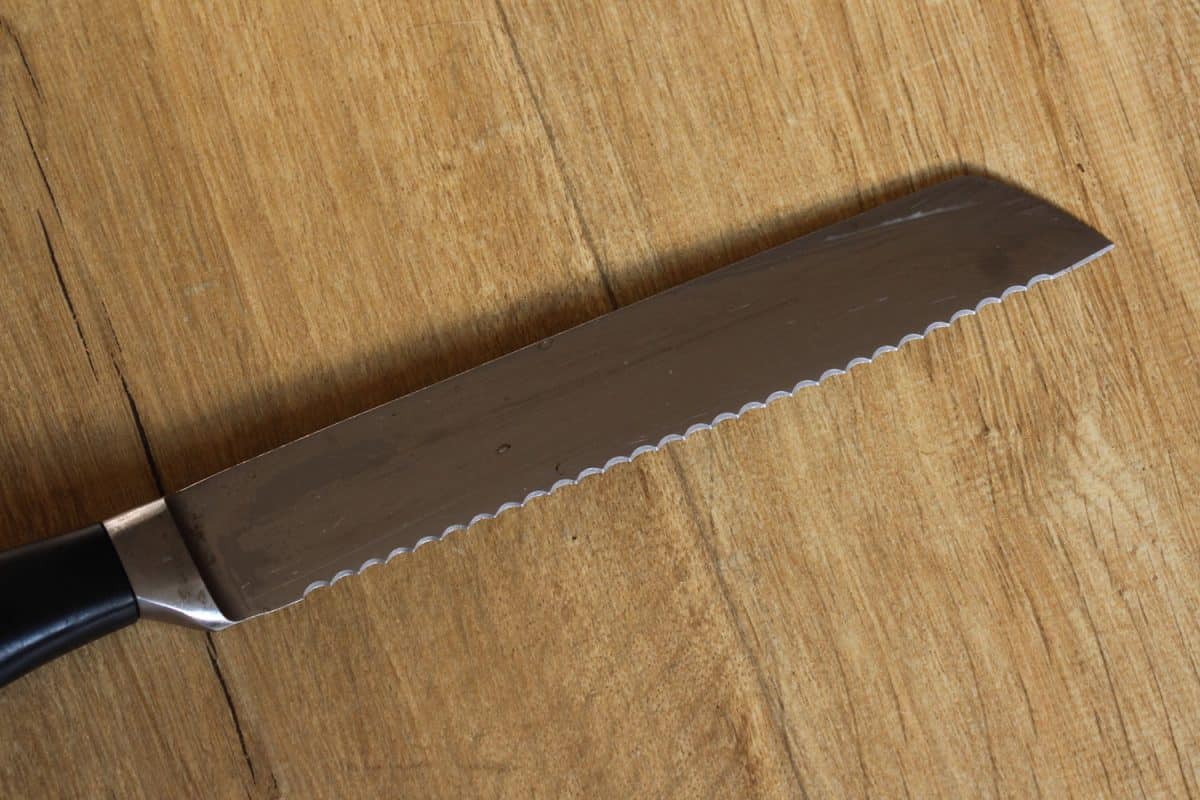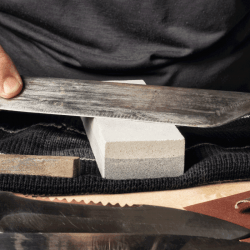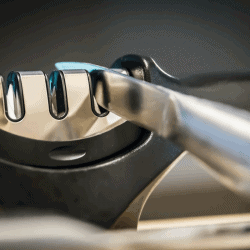Sharpening knives can be pretty straightforward. Big knife, small knife, you’re likely to have a method of sharpening that works for you. You can sharpen most of your knives the same way but inevitably you need to sharpen your serrated bread knife and you're stumped! Using your foolproof knife sharpening technique doesn’t work on this knife. We’ve done the research and we’re here to tell you the best ways to sharpen your serrated bread knife!
The best way to sharpen a serrated knife at home is by hand. For optimal results, you need a tool called a honing rod, also known as a sharpening rod. A honing rod can be made of ceramic or steel. Another tool that works well for serrated bread knives is a Spyderco Sharpmaker.
In this article, we will explain everything you need to know about getting your serrated bread knife perfectly sharp. We'll cover how to use both of the tools mentioned above, what you need to know about electric sharpeners, and when it’s really time to sharpen the knife. We will also mention tips for purchasing a serrated knife sharpener and more!

How to Sharpen A Bread Knife with a Honing Rod
First things first! What is the best way to sharpen a serrated bread knife? The basic and best way to do this is by using a honing rod. This honing rod can be ceramic or steel. The material ceramic happens to be harder than steel and can get the knife sharper. We recommend using a ceramic honing rod for best results.
It is useful now to mention some bread knife anatomy. The bread knife blade has two sides. A flat side and a side with beveled angles that have been evenly chiseled out of the blade. These beveled angles come out to a serrated groove called a gullet. Each gullet comes to a point that connects it to the next gullet. These points are called the teeth of the knife.
Sharpening Tips
Begin to sharpen your knife by choosing a gullet. Place the honing rod in the gullet at the same angle as the chiseled beveled angle inside the groove. Without applying too much pressure, run the rod through the groove two to three times. You will need to do this for every gullet on the knife. This will also help bring the knife’s teeth back to a point.
Yes, this could take a very long time. However, serrated bread knives are known for keeping their sharpness longer than any other knife. Chances are you won’t have to sharpen this knife too often. It is worth taking the time to do it well.
After sharpening each of the sedated gullets on the knife, you will notice there may be burrs poking out on the flat side of your knife. Slide the knife’s flat side down the honing rod two to three times with slight pressure to remove the burrs.
As you sharpen your bread knife, you may also notice that it is easy to change the shape of the blade. The honing rod is the tool that works best because it helps maintain the shape of the chiseled groves, serrated gullets, and the teeth of the knife.
Ideally, bread knives are sharpened only when necessary. Sharpening this knife too often could compromise its shape. Using the wrong tool and the wrong angle can also compromise the shape. Once the knife loses its shape, it becomes much harder to sharpen in the future and it will not cut bread the way it was intended to.
Click here to see a steel honing rod on Amazon.
Click here to see a ceramic honing rod on Amazon.
How to sharpen a serrated knife with a Spyderco Sharpmaker

To do this, first, you will need to set up the tool. The Spyderco Sharpmaker comes with triangular knife sharpeners. Slide one sharpener into the hole farthest from the handle with its angle facing the center. Place another triangular sharpener in the hole closest to the handle with a flat surface facing the center.
Now it’s time to sharpen your knife. Slowly slide the serrated side of your bread knife down the sharpening stone farthest from the handle. The chiseled grooves will fall in and out of the angle on the triangular sharpener. Start at the top of the sharpener and smoothly glide the knife to the bottom. In the same motion, slide the knife from the tip to its heal. Do this motion several times until the knife appears to be sharpened.
Using the sharpening stone closest to the handle, run the flat side of your blade along the smooth surface of the triangle to get rid of any burrs that likely were created during sharpening. Burrs are a sign that you are chiseling parts of the blade away and making the knife sharper. Swipe the flat end of your blade aghast the flat side of the triangle two to four times to remove all burrs.
Click here to view a Spyderco Sharpmaker on Amazon.
Here is a video of both techniques explained above. This video will show you both processes in action:
When to Sharpen your Bread Knife
Yes, bread knives, especially carbon steel bread knives, will go years without needing to be sharpened. This is why a lot of people will resort to using their bread knives while cooking dinner. It is the last knife in their set with a sharp blade. That being said, bread knives should only be used for bread because other foods can bend the teeth.
You will know it’s time to sharpen your blade when there are far too many crumbs from your bread on the cutting board. Your bread might also be squished from having to apply excessive force with your hand. Your loaf will probably come out sliced unevenly. When these things happen, it is time to sharpen your bread knife.
Buying a Knife Sharpener
There are several things to consider when buying a bread knife sharpener. First off, you need to determine which type you want. Ceramic honing rod, steel honing rod, or Spyderco Sharpmaker.
When buying a honing rod, consider comfort. You will be holding this tool for some time while sharpening the knife, so you're going to want it to feel nice on your hand. Consider the size. Most bread knives with eight-inch blades will fit with a standard-sized honing rod.
Consider the brand. Knife brands especially are associated with the quality of their product. Wusthof knives are the best kitchen knife brands rated by consumer review.
What is the best way to sharpen a serrated knife?

The best way to sharpen a serrated knife is with a honing rod. Preferably a ceramic honing rod. Place the rod at the angle of the chiseled bevels and gently glide the rod through each one. This sharpens the serrated gullets and the teeth. It is the most effective way to sharpen all the angles of the serrated edges and it helps maintain the knife’s shape.
How do you sharpen a serrated bread knife without a tool?
If you don’t have a serrated knife sharpener and you have no inclination to buy one, try using a ceramic coffee mug. The bottom rim on the mug needs to be rough for this to work. The rim should be round enough to fit into the serrated gullets at the correct angle. If it does, give it a go.
Slide the knife’s gullets around the bottom rim. If the rim is not the right shape or you are unable to achieve the right angle, we recommend not using a coffee mug because it is very easy to distort the shape of the knife.
Can you sharpen serrated knives with an electric sharpener?
As for electric sharpeners, people who sharpeners knives for a living will tell you there is no electric serrated knife sharpener. The highest quality knife sharpeners often do come with a serrated knife setting. However, they are unable to reach the entire serrated gullets of the knife’s serrated edge. Electric sharpeners leave the job incomplete. It's much better to do it by hand.
Can you use a whetstone to sharpen a serrated knife?
The answer is yes. To do this, you would use an old file to round out an angle on a whetstone to fit the gullet of your serrated knife. Then you would push the knife through at the angle of the beveled angle several times. When the serrated side is sharp and the teeth are sharp, you’re done.
If your whetstone isn’t filed to the correct curve or you hold your knife at the wrong angle, it could distort the shape of the knife. This is not the best way to sharpen a knife but it would work in a pinch.
Click here to view this whetstone on Amazon.
In Closing
We hope that with this guide, you are confident in sharpening your serrated bread knife. Honing rods and knife sharpeners will be your best friends in this process. Best of luck!
Before you go, be sure to check out these other guides that may be of interest to you:
Do You Need To Wash A Knife After Cutting Bread? [And Other Care Tips For Bread Knife]
Is A Bread Knife Good For Cutting Brisket?






![knife and old iron sharpener with handle for kitchen knives on a white background, Do Knife Sharpeners Wear Out? [And When To Replace Yours]](https://kitchenseer.com/wp-content/uploads/2021/09/knife-and-old-iron-sharpener-with-handle-for-kitchen-knives-on-a-white-background-250x250.jpg)



